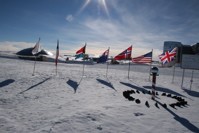Miami artist Xavier Cortada, a National Science Foundation (NSF) Antarctic Artists and Writers Program recipient, traveled to Antarctica during December 2006 – January 2007 to create new works and implement various art projects (see below).
Making a point where the Earth’s longitudes converge
The Longitudinal Installation
Cortada placed 24 shoes in a circle around the South Pole, each serving as a proxy for a person affected by global climate change in the world above. He placed the shoes inches apart along the respective longitudes where these individuals live, conceptually diminishing the distance between them. Please click on the image to read their statements across 24 time zones.
 Endangered World
Endangered World
Cortada planted 24 flags around the South Pole to warn of the imminent threat to Earth’s biodiversity. Using melted sea ice and acrylic paint, he wrote the scientific name of an endangered species on each flag, as well as the longitude of the habitat in which it struggles for survival. Please click on image to read Cortada’s list of the 24 endangered animals.
Marking time with a moving ice sheet
Cortada uses the moving ice sheet that blankets the South Pole to mark time: Important events that have moved the world forward during the past 50 years (“The Markers“) are juxtaposed with events that occur in broader geological time frames (The “150,000-year Journey“).
 The Markers
The Markers
Cortada planted 51 different colored flags on the moving ice sheet that covers the South Pole, each 10 meters apart and marking where the South Pole stood during each of the past 50 years (when humans first inhabited the South Pole). Each flag also displayed the coordinates of the location on the world above where an important event that took place during that year. Please click on image to read the list of historic events that have moved the world forward during the past five decades.
 The 150,000-year Journey
The 150,000-year Journey
Cortada planted an ice replica of a mangrove seedling on the moving ice sheet that blankets the South Pole. Embedded in the ice, the seedling will move 10 meters a year in the direction of the Weddell Sea, 1400 km away. In 150,000 years, the seedling will arrive at the coastline and theoretically set its roots.
Painting on the Ice
Ice paintings
Cortada created “ice paintings” using sea ice, glacier and sediment samples provided to him by scientists working in Antarctica. The artist titled the works on paper by randomly selecting the names of geographic features from a map of the continent that inspired their creation. Please click on image to see ice paintings.
 The Shackleton (in the South Pole) Painting
The Shackleton (in the South Pole) Painting
Cortada created a portrait of Sir Ernest Shackleton, who came within 97 miles of being the first to reach the South Pole. The Antarctic explorer attempted to traverse the continent in a follow-up expedition, but wound up marooned with his 27 men on a polar ice floe. Enduring the harshest conditions for almost two years, they all survived. Cortada thought to honor Shackleton’s heroism by permanently “placing him” in the South Pole, the place that so eluded him in life.
“This is an exciting project that will result in a positive and meaningful body of work,” says Kim Silverman, Program Director for the National Science Foundation’s Antarctic Artists and Writer’s Program. “Xavier’s project represents a new and progressive dimension in artistic expression, adding breadth to the Program.”